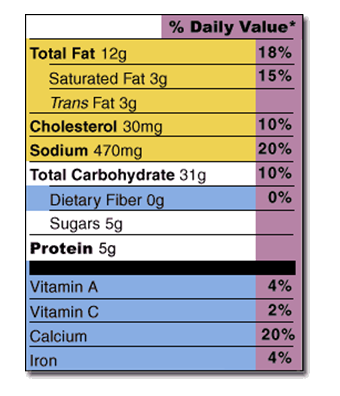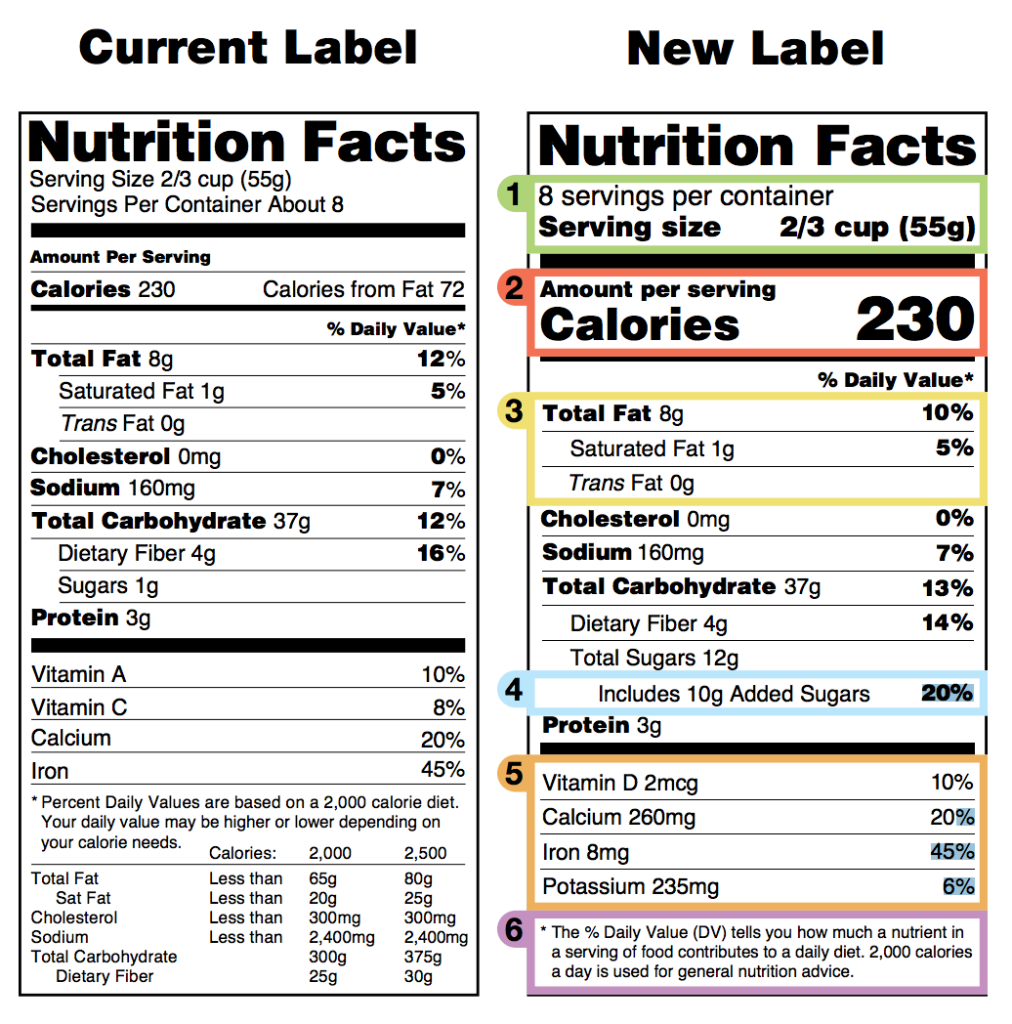38 nutrient requirements that are listed as percentages on food labels
Your Ultimate Guide to Food and Nutrition Labels - Aaptiv Labels. "Food labels are basically any claim made on a food product, from hard-core facts regulated by government agencies—FDA, USDA—to promotional hype generated by advertising agencies," Passler explains. This is where labels can get misleading. Terms such as "light" and "enriched with" have specific, regulated meanings. USDA ERS - Food Labeling The Nutrition Facts Label (NFL), mandated through the 1990 Nutrition Labeling and Education Act (NLEA), is a familiar feature on packaged food. The label has changed only slightly since its inception in 1994, with trans fat added in 2006 to the nutrients required to be listed. In a 2012 report, ERS researchers found that between 2005 and 2010 ...
FDA Food Product Labeling & Packaging Requirements | ESHA Research Mandatory nutrients (total calories, total fat, saturated fat, trans fat, cholesterol, sodium, total carbohydrate, dietary fiber, total sugars, added sugars, protein, vitamin D, calcium, iron, potassium) Placement: In general, place the Nutrition Facts Label on the PDP or the Information Panel, near the ingredient statement. Ingredient Statement
Nutrient requirements that are listed as percentages on food labels
Daily Value on the New Nutrition and Supplement Facts Labels Feb 25, 2022 · 5% DV or less of a nutrient per serving is considered low. 20% DV or more of a nutrient per serving is considered high. More often, choose foods that are: Higher in dietary fiber, vitamin D,... PDF Declaring Voluntary Nutrients on Your Nutrition Facts Label Genesis R&D Foods, first released in 1991, is designed to help users manage processes, overcome industry challenges, and meet federal requirements. Industry professionals use Genesis R&D for quick and accurate nutrient evaluation, virtual product development, nutrition labeling, and regulatory compliance •Product Development •Formulation ... Food Labeling Requirements - LabelCalc New August 2019 FDA Industry Guidance for Food Labeling: Folate, Niacin, Vitamins A, D & E. As of August 2019, the FDA released new guidance for the industry concerning food labeling for certain micronutrients listed on the nutrition facts label on food products.. Folate, Niacin, as well as Vitamins A, D, E are all receiving a do-over in their appearance on the nutrition facts label to be more ...
Nutrient requirements that are listed as percentages on food labels. Optional Nutrients On The Food Label - LabelCalc Dietary fiber. Sugars. Protein. Vitamin A. Vitamin C. Calcium. Iron. These nutrients are mandatory because the FDA considers them the most essential to either limit our intake of (in the case of cholesterol, sodium, and trans fat) or increase our intake of them (in the case of iron, Vitamin C, and dietary fiber). The Basics of the Nutrition Facts Label Mar 04, 2022 · You know about calories, but it also is important to know about the additional nutrients on the Nutrition Facts label. Protein: A percentage Daily Value for protein is not required on the label. Eat moderate portions of lean meat, poultry, fish, eggs, low-fat milk, yogurt and cheese, plus beans and peas, nuts, seeds and soy products. Food Labels | Nutrition.gov Food labels can help you make healthy choices when buying food in grocery stores or restaurants. ... Learn about organic foods, requirements, and how they are labeled. ... has updated the Nutrition Facts label on packaged foods and beverages with a fresh design that will make it easier for you to make informed food choices that contribute to ... Nutrition labelling - Food Safety It must provide the energy value and the amounts of fat, saturates, carbohydrate, sugars, protein and salt of the food. The declaration must be presented in a legible tabular format on the packaging. Where space does not permit it, the information may be presented in linear format.
Codex Guidelines on Nutrition Labelling For the purpose of these guidelines: 2.1 Nutrition labelling is a description intended to inform the consumer of nutritional properties of a food. 2.2 Nutrition labelling consists of two components: (a) nutrient declaration; (b) supplementary nutrition information. 2.3 Nutrition declaration means a standardized statement or listing of the ... Presentation of Nutrition Information on Food Labels - Nutrition ... To assure that the nutrition information provided on a food label is conveyed in a manner that will allow the majority of consumers to use it successfully, a number of criteria need to be considered, including literacy of users, computational abilities, knowledge of English, and knowledge of the specialized vocabulary of nutrition labeling. Nutrition labelling | Food Standards Agency View Q&A on nutrition requirements in Regulation 1169/2011 on the provision of food information as PDF(Open in a new window) (216.39 KB) Applies to Northern Ireland only, for England DHSC are responsible for nutrition labelling, Welsh Government in Wales and Food Standards Scotland have responsibility in Scotland. Nutrition information panels - Food Standards Nutrition information panels (NIP) on food labels provide information on the average quantity of energy in kilojoules or in kilojoules and kilocalories and these nutrients: ... The figures in the 'quantity per 100 g' column are the same as percentages. For example, if 20 grams of fat is in the 'per 100 g' column, the product contains 20 ...
PDF NUTRITION LABELLING INFORMATION - Food Standards Agency of the requirements of the legislation applying to pre-packed foods on 13 December 2014. From 13 December 2016 mandatory nutrition declarations for most pre-packed foods* will apply. This means that if you sell pre-packed food then you must include the following information on the package or on the label. Supplementary Information The New Nutrition Facts Label | FDA Apr 13, 2022 · The U.S. Food and Drug Administration (FDA) has updated the Nutrition Facts label on packaged foods and drinks. FDA is requiring changes to the Nutrition Facts label based on updated scientific... Food Labels | CDC If you eat the whole thing, you are eating 8 times the amount of calories, carbs, fat, etc., shown on the label. Total Carbohydrate shows you types of carbs in the food, including sugar and fiber. Choose foods with more fiber, vitamins, and minerals. Choose foods with lower calories, saturated fat, sodium, and added sugars. Avoid trans fat. Understanding Food Labels | The Nutrition Source | Harvard T.H. Chan ... The percent Daily Value (%DV) shows how much of a nutrient in one serving of food contributes to one's approximate daily requirement for the nutrient. To best use the %DV, remember these simple guidelines: 5% DV or less of a nutrient per serving is considered low.
Learn How the Nutrition Facts Label Can Help You Improve Your Health Nutrients Required on Label Vitamin D and potassium values are required. Calcium and iron will continue to be required. Vitamins A and C will no longer be required but can be included on a voluntary basis. Slight Decrease in Sodium Allowance The daily limit for sodium decreased slightly from 2,400 mg per day to 2,300 mg per day.
Changes to the Nutrition Facts Label | FDA The Nutrition Facts label on packaged foods was updated in 2016 to reflect updated scientific information, including information about the link between diet and chronic diseases, such as obesity...
Understanding Nutrition Facts on Food Labels - WebMD The percentages next to each nutrient -- such as fat, sodium, fiber, protein -- can help you determine whether a food is "high" or "low" in that nutrient. And 5% or less is considered to be "low,"...
How To Read Food and Beverage Labels - National Institute on Aging The percent Daily Value (% DV) tells how much a nutrient in a serving of the food or beverage contributes to a total daily 2,000-calorie diet. Although the average person needs 2,000 calories a day to maintain their weight, individuals may need more or fewer depending on their lifestyle.


Post a Comment for "38 nutrient requirements that are listed as percentages on food labels"